VR Training Statistics for Adoption, Efficacy and Real World Results
VR Training Statistics for Adoption, Efficacy and Real World Results
Virtual reality training has been gaining ground in businesses looking to make improvements to employee training programs. Some of the first use cases were heavy equipment training where expensive machinery had to be shut down or trainees had to travel far to be trained. By simulating the equipment training with VR, companies saw a huge reduction in training costs. Soon, use cases for improving workplace safety and filling the skilled labor gap caught on. VR training is now also being used for soft skills training and even to boost employee wellness.
But does it really work?
Here’s what we found from VR training studies—the cumulative evidence is very convincing.
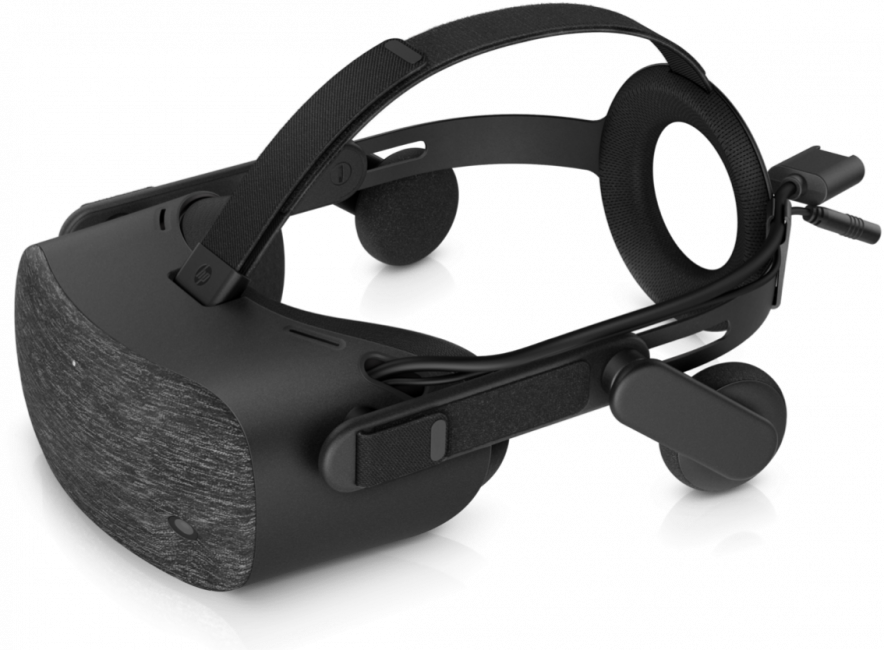
VR Training Adoption Statistics
Factors such as remote work during the pandemic, an increasing skilled labor gap, and the rise of millennials in the workforce have all contributed to the shift in VR training as a novelty to it quickly becoming a mainstream practice. Sean Hurwitz, VR training veteran and CEO of PIXO VR, commented after attending the 2022 Training Conference that, “The market as a whole has matured from ‘what is VR?’ to ‘how can I utilize VR?’.”
Some of the statistics to the right arose during the pandemic as remote work added challenges for training directors. The numbers are likely much higher in 2022 and will continue to rise.
26%
Of businesses in 2020 were using VR/AR to train employees (Tech Republic)
39%
Of enterprises leverage VR/AR technology to facilitate training (Chaos Theory Games)
70%
Of professionals believed that VR/AR for training would be a focus for 2021 (Perkins Coie)
Contact Us to Learn More!
Top Sectors for VR Use:
- Workforce training and development
- Healthcare
- Education
- Manufacturing
- Automotive
- (Perkins Coie)
$1.66 Billion
Of enterprises leverage VR/AR technology to facilitate training (Chaos Theory Games)
81%
Of professionals believed that VR/AR for training would be a focus for 2021 (Perkins Coie)
Workforce training and development was listed as one of the top areas adopting VR technology. Within training, the most common use cases are workplace safety, where VR content is standard and can be used by any company. There has also been a big investment in standard and custom content to overcome the skilled labor gap. Companies can’t find workers with experience in their areas, so VR training is being used to teach everything from meter inspection to working on an oil rig. Another fast-growing use case is soft skills training. VR training modules are highly effective in conflict and diversity training—giving trainees an opportunity to test out skills in simulated, yet very real-world situations.
The rise of VR adoption in the remaining sectors is also training related. In healthcare, VR is being used to train nurses and doctors. In education, classrooms are beginning to adopt VR for a young audience that is already comfortable and eager to use it. Manufacturing and automotive are using VR both for training as well as for product development.
All of these use cases are showing value by increasing hands-on experience without the need for job shadowing or taking precious resources (people or equipment) away from their day-to-day work. Controlled experiences in VR make sure trainees experience what they need to learn without waiting around for a specific event to happen. All of this is not only effective, but also brings cost savings. The applications for VR training continue to grow as more industries consider how to take advantage of this technology.
VR Training Programs Efficacy Statistics
There have been some great studies that prove that our brains retain information better, learn faster, and result in better outcomes when using VR for training. However, it may also help to understand that scientists have proven that virtual reality helps the brain to learn and retain information. Scientists have shown that our perception of reality comes from a mental map of our environment created from using the five senses. The more information we take in, the more cognition develops. When it comes to prediction, the brain does its best to fill gaps and predict what will happen next based on memory.
When VR learning is introduced, it actually rewires the brain and can enhance neural connections for learning and memory. When a person is in a VR simulated environment, the brain is seeing and doing what is required without gaps. It is this rewiring that results in VR trainees to learn quicker and more effectively.
75%
Is the retention rate of VR training in schools, beating out lectures (5%), reading (10%), and audio-visual learning (20%) (National Education Association)
8.8%
Was the average increase in memory recall using VR in a study comparing VR and desktop learning (University of Maryland)
12%
higher accuracy and 17% faster time to completion was the result of a skilled labor study using VR training versus instructional video (Accenture)
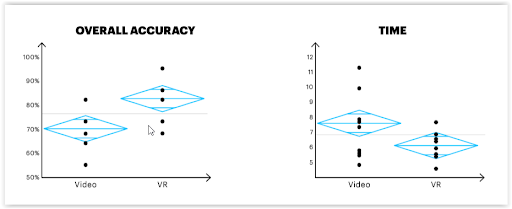
43%
Was the reduction in lost time from injury since the introduction of VR safety training in mining (Minesafe International Conference)
100%
Of welding students who used VR training performed better on weld testing than students receiving traditional training (Iowa State University)
82%
Of companies implementing AR/VR indicate that the benefits exceed expectations (Capgemini)
A recent survey from The National Association of Business Economics (NABE) found that 47% of respondents reported a shortage of skilled workers in the third quarter of 2021. This was a significant increase from 32% reported the quarter before. Reports say that post-pandemic this shortage is only growing. Hurwitz noted that training directors are struggling to resolve this issue. Specifically because of, “talent shortages, a shifting company culture, and the need for employers to adapt their practices to keep a younger generation engaged.”
VR training is becoming a very viable way to fill this gap. The younger workforce is very comfortable with VR technology and is much more responsive to training received in this way. Combined with the efficacy of VR training, this allows companies to begin to hire for ability to learn and cultural fit instead of prior experience. VR training modules can then be used to teach the skills the company needs. The Accenture VR study data shown below demonstrated how effective VR training was to teach non-skilled individuals how to install a toilet.
Workplace safety is another important application for VR training. Keeping injuries to a minimum is good for workers and good for business, yet not much has changed in safety training over the years. With its increased efficacy, it makes sense that one of the most popular applications for VR is safety training. For instance, in Fall Protection VR training, a trainee actually experiences the feeling of falling—which is highly effective feedback for the brain to avoid the behaviors that lead to that outcome. It’s no wonder that the mining industry saw a 43% reduction in time off due to injury after introducing VR training.
Contact Us to Learn More!
Statistics on Virtual Reality Training Programs for Soft Skills
One of the gaps in soft skill training has always been the difficulty of creating an environment that simulates a real world situation. This is especially true for topics like conflict resolution and diversity and inclusion training. VR allows trainees to feel like they are truly talking with an upset customer or a colleague of a different race. More importantly, it allows them to work through that situation without holding back or being fearful of hurting someone’s feelings.
A great article on virtual reality for soft skills training highlighted the experience of Cornell Verdeja-Woodson, founder and president of Brave Trainings, who used VR training to educate managers about unconscious bias in workforce decisions. “We had previously held workshops on the topic, but no training on what to actually do in the moment when you perceive bias or harassment happening,” Verdeja-Woodson says. “To get people to really buy in and take action, they need to see it happening right in front of them. After the virtual reality simulations, the reaction from managers often is, ‘Wow, that’s what it really can look and feel like.’ ” VR training is opening up new possibilities in training empathy and interpersonal skills.
PwC recently did a study of VR designed for soft skills training. Employees from a group of new managers in 12 US locations took an inclusive leadership training via classroom, e-learn, or VR training. The results, shown below, demonstrate that VR training was faster and more effective than traditional training methods. Even looking at costs it performed better than other methods at scale.
VR Learners Are:
3.75x more emotionally connected to content than classroom learners

275% more confident to apply skills learned after training
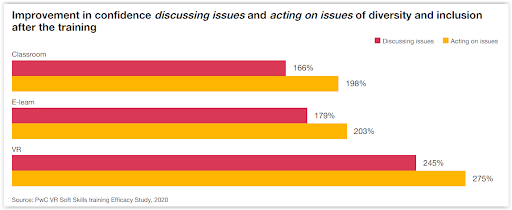
4x faster to train compared to classroom training
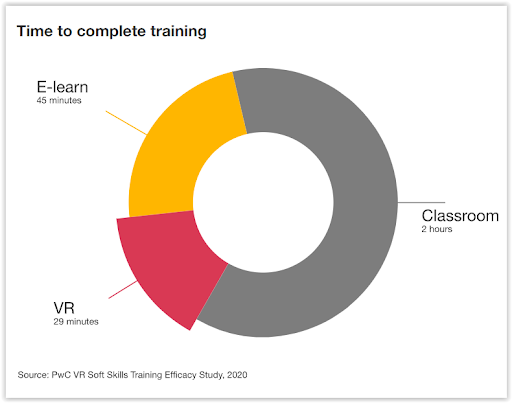
4x more focused than e-learning peers
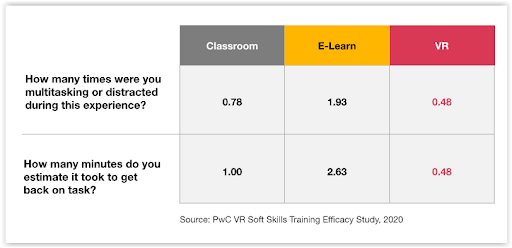
Learning for less $ as VR learning is more cost effective than e learning or classroom learning at scale
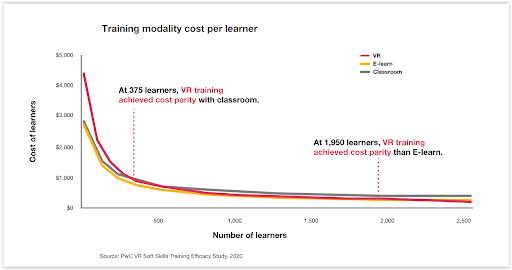
The interesting point about the cost analysis done by PwC is the ability to scale VR training. The pandemic brought new challenges for training directors to get training done remotely. VR training works very well for extending training to different locations without the costs of sending instructors or having trainees travel, and without losing training efficacy.
Another consideration is that PwC’s analysis only compares the cost of the training content and equipment. The biggest cost savings comes from factors like:
- Reducing the time to onboard or to complete the skills training
- Eliminating or reducing the need for expensive equipment to be used
- Eliminating or reducing the travel costs for instructors and trainees
- Eliminating or reducing the need for job shadowing
- Reducing the skilled labor gap and filling open positions faster
- Improving outcomes—like worker safety, company culture, employee engagement, and higher efficiency
All of these factors reduce costs and improve bottom lines. Those responsible for company training have a great opportunity to make a significant impact on key business objectives by incorporating VR training into their employee training programs.
Contact Us to Learn More!
Results from Companies Using VR Training Programs
Nothing speaks better to VR training effectiveness than the big names companies that are already doing it and seeing great results. These companies are seeing improved engagement in training as well as big improvements in training efficacy and cost reduction. And they’ve applied VR training to everything from soft skills to hard skills and onboarding to regular safety certifications. Check out these impressive statistics from companies using VR for employee training.
Walmart
Saw a 70% improvement on test scores for workplace tests after using VR training. They also saw a 30% increase in employee satisfaction with training.
Verizon
Found VR safety training was significantly more effective than classroom training and now uses it for 22,000 front line employees across all 1,600 US stores.
Telstra
Realized a 50% reduction in the direct time required to complete staff safety training and VR remote training allowed them to stay compliant during Covid restrictions.
Boeing
Realized a 75% reduction in equipment training time with VR training.
Homegrown
Restaurants saw a 27% increase in the success of employee onboarding using VR training.
United Rentals
Saw a 50% reduction in the time to train employees when using VR training.
Airbus
Uses VR to optimize maintenance via simulated protocols. The use of VR technology has enabled Airbus to reduce the duration of maintenance processes by 25%.
H&R Block
Uses VR training to teach new agents soft skills resulting in faster onboarding and 50% reduction in customer hold time due to increased competency in solving issues.
DHL Express
Uses VR training to boost efficiency in Unit Load Device (ULD) stacking and safety where 90% of employees said VR is helping them improve efficiency and work better.
Amerisure
Uses VR safety training to improve outcomes with construction policy holders, which has been well received and seen as an asset to supplement classroom training.
Intel
Uses VR training and 94% of trainees ask for more VR training content. They also project the 5-year ROI of a single VR-based course could reach 300%.
JetBlue Airline
Was able to replace hands-on technician training (which involved renting an aircraft at a significant cost) with VR training.
So what does the future hold for VR training? There is no question that it will continue to grow in use cases and adoption. That said, VR training isn’t the best training method for every use case. Training programs at companies (whether soft or hard skills) will likely continue to use a mix of training methods and technology while blending in VR training to improve outcomes for best fit use cases in their organizations.
Want to read about more companies using VR training? See real-world results here.
Is there a new VR training study or statistic you didn’t see on this page? We’d love to include it. Contact us with the link to the study and we’ll add it asap.
VR Training Statistics References
- 91% of businesses already using or planning to adopt AR or VR technology. TechRepublic
- Infographic: The Future Of Workplace AR & VR Training. Chaos Theory Games
- Perkins Coie study: Industry leaders weigh in on the future of Ar and VR. Perkins Coie
- Worldwide Spending on Augmented and Virtual Reality Forecast to Deliver Strong Growth Through 2024. IDC
- Capgemini study: Augmented and Virtual Reality in Operations. Capgemini
- National Education Association. Is VR training more efficient than other learning methods? FrontCore
- University of Maryland study originally published in Virtual Reality journal. Science Daily
- Accenture Study on Extended Reality Immersive Training. Accenture
- Virtual reality for mine safety training study by A.P Squelch published at the Minesafe International Conference. Echelon
- Study from Iowa State University published in the Welding Journal
- Pwc study: How virtual reality is redefining soft skills training. PwC
- VR for Corporate Training: Examples of VR already being used. Virtualspeech
- Corporate Training with Virtual Reality. Intel
- Boeing: Productive VR Cuts Training Time by 75%. LightReading
- Stepping into the virtual world to enhance aircraft maintenance. Airbus
- How CR Can Make the Workplace Safer. EHS Today
- 7 key elements of VR training to boost employee engagement. United Rentals
- The Growing Impact of Virtual Reality Training. SHRM